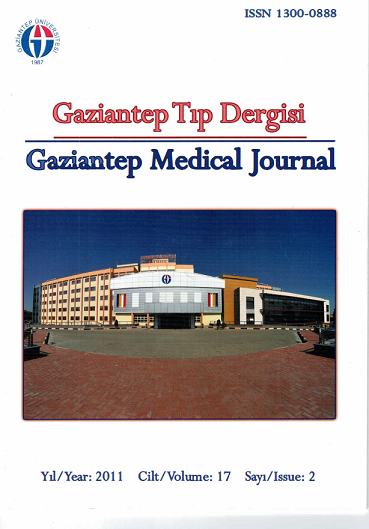Hereditary angioedema on the occasion of a pediatric case
Bir çocuk olgu nedeniyle herediter anjioödem
DOI:
https://doi.org/10.5455/GMJ-30-2011-23Keywords:
Hereditary angioedema, fresh frozen plasma, treatmentAbstract
Hereditary angioedema is a rare and life threatening autosomal-dominant disorder which results from the congenital deficiency of C1- esterase inhibitor. It is responsible for approximately 2% of all angioedema cases. Recurring angioedema attacks that involve subcutaneous and submucosal areas are the hallmarks of hereditary angioedema. Here, we review the clinical findings and therapeutic approaches of the disease by presenting a 5-years old female patient with severe extremity edema who was diagnosed as hereditary angioedema and treated with fresh frozen plasma.
Metrics
References
Frank MM. Complement in the pathophysiology of human disease. N Engl J Med 1987;346(24):1525-30.
Agostoni A, Cicardi M. Hereditary and acquired C1-inhibitor deficiency: biological and clinical characteristics in 235 patients. Medicine 1992;71(4):206-15.
Bock SC, Skriver K, Nielsen E, Thøgersen HC, Wiman B, Donaldson VH, et al. Human C1 inhibitor: primary structure, cDNA cloning and chromosomal localization. Biochemistry 1986;25(15):4292–301.
Herrmann G, Schneider L, Krieg T, Hunzelmann N, Scharffetter-Kochanek K. Efficacy of danazol treatment with the new variant of hereditary angioedema (HAE III). Br J Dermatol 2004;150(1):155-77.
Anderson MW, deShazo RD. Studies of the mechanism of angiotensinconverting enzyme (ACE) inhibitor-associated angioedema: the effect of an ACE inhibitor on cutaneous responses to bradykinin, codeine, and histamine. J Allergy Clin Immunol 1990;85(5):856–8.
Agostoni A, Aygoren-Pursun E, Binkley KE, Blanch A, Bork K, Bouillet L, et al. Hereditary and acquired angioedema: problems and progress: proceedings of the third C1 esterase inhibitor deficiency workshop and beyond. J Allergy Clin Immunol 2004;114(3 Suppl):S51-131.
Bork K, Meng G, Staubach P, Hardt J. Hereditary angioedema: new findings concerning symptoms, affected organs, and course. Am J Med 2006;119(3):267-74.
Farkas H, Fust G, Fekete B, Karadi I, Varga L. Eradication of Helicobacter pylori and improvement of hereditary angioneurotic oedema. Lancet 2001;358(9294):1695-6.
Farkas H, Varga L, Széplaki G, Visy B, Harmat G, Bowen T. Management of hereditary angioedema in pediatric patients. Pediatrics 2007;120(3):713-22.
Hill BJ, Thomas SH, McCabe C. Fresh frozen plasma for acute exacerbations of hereditary angioedema. Am J Emerg Med 2004;22(7):633.
Farkas H, Gyeney L, Gidofalvy E, Fust G, Varga L. The efficacy of short-term danazol prophylaxis in hereditary angioedema patients undergoing maxillofacial and dental procedures. J Oral Maxillofac Surg 1999;57(4):404-8.
Bowen T, Cicardi M, Farkas H, Bork K, Kreuz W, Zingale L, et al. Canadian 2003 international consensus algorithm for the diagnosis, therapy, and management of hereditary angioedema. J Allergy Clin Immunol 2004;114(3):629-37.
Downloads
Published
How to Cite
Issue
Section
License
Copyright (c) 2023 European Journal of Therapeutics

This work is licensed under a Creative Commons Attribution-NonCommercial 4.0 International License.
The content of this journal is licensed under a Creative Commons Attribution-NonCommercial 4.0 International License.


















